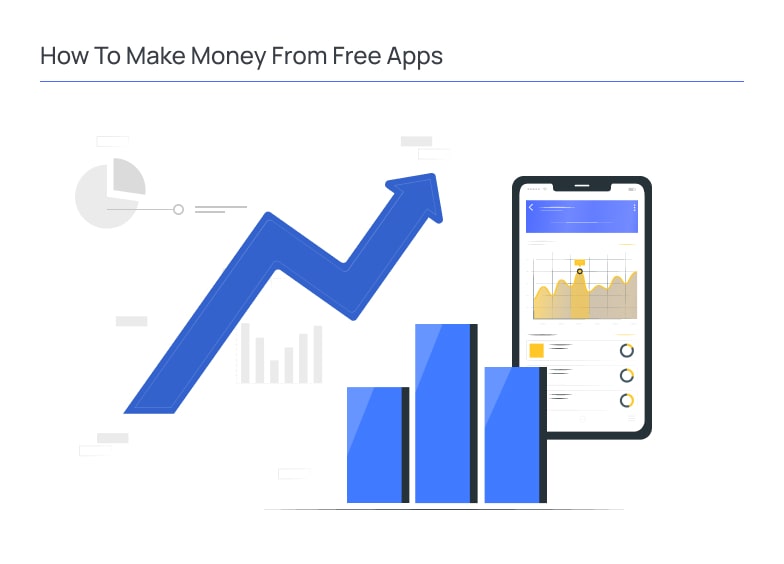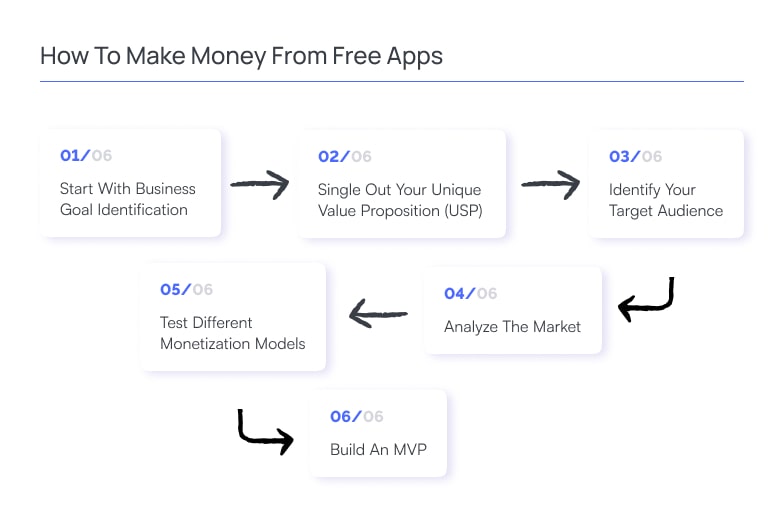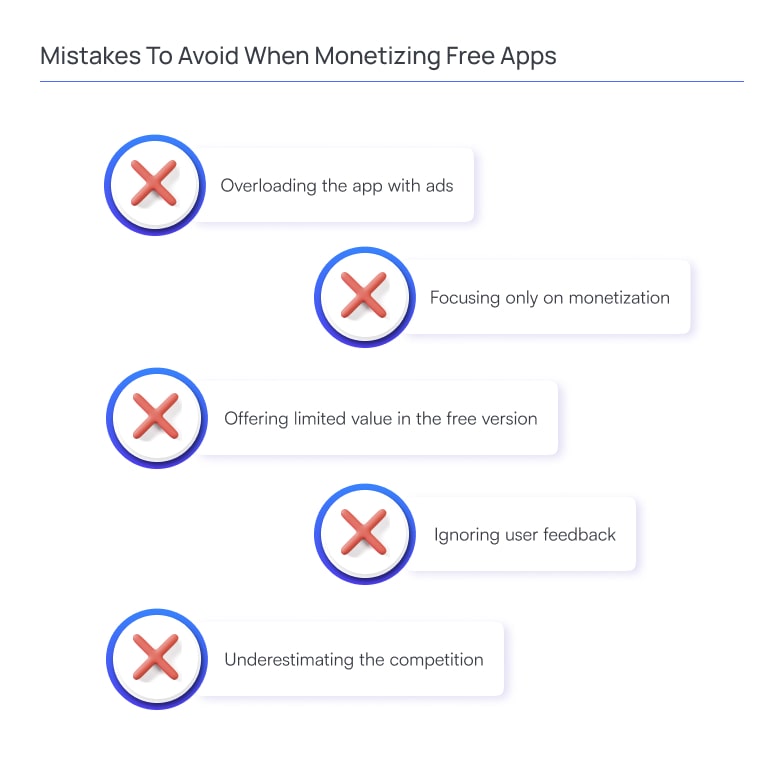In the digital age, free apps have become integral to our lives. There’s an app for almost everything, from streaming music to playing games. But how do these apps make money if they’re free? The answer lies in app monetization strategies.
App monetization is the process of turning an app into a revenue-generating product. There are several ways to monetize an app, and understanding the different strategies is critical to maximizing profits. This article will explore how to make money on a free app and discuss the best monetization strategies for app developers.
Free Apps vs. Paid Apps: An Overview
The mobile app market is highly competitive and rapidly evolving. As app owners seek to monetize their apps, they face a fundamental decision: offering their app for free or charging users. Two of the most common models for app monetization are freemium and paid apps.
Freemium apps are available for free download but offer additional features or content for a fee. Users can download the app and use its basic features without charge, but they can pay for extra features or content not included in the free version. This model is often used for apps that offer in-app purchases, subscriptions, or advertising.
On the other hand, paid apps require users to pay a one-time fee before downloading and using the app. Once users have paid for the app, they can access all its features and content without additional charges.
Statista says that as of November 2022, 97 percent of Google Play apps were free. Like the Apple Store, the Google Play Store has constantly had more free apps than paid apps. Comparatively, in December 2021, free Android apps on the Amazon Appstore made up over 80% of the total apps offered in the store, while paid apps made up 18% of the total.
How Much Money Do Free Apps Earn?
The amount of money free apps make varies widely and depends on several factors, such as the app’s monetization strategy, user engagement, and the size of its user base. While some free apps generate significant revenue, others need help to earn enough to cover their development costs.
- In 2020, the top-grossing free app on the App Store was TikTok, which generated an estimated $540 million in revenue from in-app purchases and advertising, according to Sensor Tower.
- A study by Sweet Pricing found that, on average, free apps with in-app advertising generate $0.04 to $0.08 per user per month in revenue, while those with in-app purchases generate $0.26 to $0.51 per user per month.
- The App Annie State of Mobile report found that in 2020, the top-grossing free-to-play mobile games in the United States generated an average of $97 per user in revenue from in-app purchases.
How To Make Money From Free Apps: Top Revenue Strategies
It is possible to use many existing strategies to enable monetization in your free app. But not every revenue model can be suitable for your app. That is why we provide a detailed list of the leading monetization strategies for your consideration.
Advertising
The Advertising revenue model is a business model that allows companies to generate revenue from their products and services through advertising. This model involves placing advertisements on websites, blogs, social media, and other digital platforms.
Companies can also use this model to generate revenue from physical media, such as television, radio, and print. The model works by allowing companies to pay for the placement of their ads on these platforms. The platforms generate revenue from the ads shared with the companies. This model benefits both companies and platforms, as it helps companies reach a larger audience and generate more revenue, while platforms can make money from the ads they host.

There are four primary types of advertising which help free apps make money – you will find them below.
Interstitial Ads
Interstitial ads are a great way to get your message out to potential customers. They are designed to be eye-catching and engaging and can be used to promote products, services, or even events.
They are typically placed between two web pages or within a single webpage and are usually short and to the point. Interstitial ads are a great way to grab viewers’ attention and encourage them to take action. Whether you want to increase sales, promote a new product, or just get the word out about your business, interstitial ads can be a great way to get the job done.
Banner Ads
Banner ads are online advertisements that appear as a rectangular graphic image or a multimedia object (such as an animation or video) on a webpage. They are typically placed at the top or bottom of a webpage and are used to promote products or services. Banner ads are commonly linked to a specific website; when clicked on, the user is directed to that website. Banner ads are an effective way to reach a large audience, as they can be seen by anyone who visits the webpage they are placed on.
In-app Video Ads
In-app video ads appear within a mobile app as a video. These ads can range in length from a few seconds to a few minutes and are typically displayed before, during, or after the user interacts with the app.
In-app video ads are popular because they provide a more engaging and interactive experience than traditional banner ads. They can also target specific audiences based on demographics, interests, and behavior.
Native Ads
Native ads are a type of advertising format that blends in with the surrounding content, appearing as a natural part of the user experience rather than a blatant ad. These ads are designed to match the form and function of the platform on which they are displayed, such as a website or social media feed.
Native ads can take many forms, including sponsored content, promoted posts, and in-feed ads. They may feature images, videos, or text and are often labeled as “sponsored” or “promoted” to distinguish them from organic content. Native ads may attract and hold users’ attention and drive higher engagement and click-through rates.
Many types of apps use this revenue model. A dating app is a good example. How do free dating apps make money? There are also some other valuable models, so read our detailed article about dating app monetization.
Referral Marketing
This is another model that describes how to make money on free apps. A referral marketing revenue model that businesses use to motivate their existing customers to refer new customers to their product or service. This is typically done by offering rewards, discounts, or other incentives to customers who successfully refer a new customer to the business.
In a referral marketing program, the existing customer advocates for the brand, using their own positive experience with the product or service to encourage others to try it out. The referred customer may be more likely to trust the recommendation of someone they know and respect, leading to a higher likelihood of conversion and customer loyalty.
Referral marketing can effectively generate new leads and customers for a business and build stronger relationships with existing customers. By offering incentives for successful referrals, the company can leverage the power of ‘word-of-mouth’ marketing to drive revenue growth.

The referral marketing model has a few types to consider:
Cost Per Acquisition (CPA)
CPA is a relevant metric for measuring the effectiveness and efficiency of referral marketing campaigns. In referral marketing, CPA refers to the cost of acquiring a new customer or lead through a referral program.
Cost Per Click (CPC)
CPC measures each click’s cost on an ad. CPC is calculated by dividing the total cost of the ad campaign by the number of clicks generated by the campaign.
CPC is commonly used in pay-per-click (PPC) advertising, where advertisers only pay when someone clicks on their ad. In PPC advertising, advertisers bid on keywords or phrases relevant to their target audience, and their ad is displayed when someone searches for those keywords or phrases. The bidding process determines each click’s cost, with advertisers competing against each other for ad placement.
Cost Per View (CPV)
CPV means that the advertiser pays for each view of their advertisement. This model is often used in video advertising, where the advertiser pays each time a viewer watches the advertisement. CPV is an effective way for advertisers to reach their target audience, as they only pay for the views that their advertisement receives.
This model can be beneficial for both the advertiser and the publisher, as it allows for a more targeted approach to advertising and can be used to measure the success of an advertisement.
Cost Per Install (CPI)
CPI measures the cost of acquiring a new user for a mobile application. It is calculated by dividing the total cost of acquiring the user (such as advertising costs) by the number of users who have installed the app. CPI is a crucial metric for app owners and marketers as it allows them to measure the effectiveness of their user acquisition strategies. Understanding CPI makes it possible to make informed decisions about how much to invest in user acquisition and which channels are the most effective for their app.
Need help with app development? Binerals provides a full-cycle development service –
Contact usSubscriptions
A subscription revenue model is a business model where customers pay a recurring fee to access a product or service. Many businesses, including media companies, software companies, and online retailers, use this model.
Under a subscription model, customers typically pay a monthly or yearly fee to access the product or service, which may include ongoing updates, support, and new features. The recurring revenue from subscriptions provides a predictable and stable source of income for the business, which can help with planning and forecasting.
To succeed with a subscription model, companies need to offer a product or service that customers perceive as valuable and willing to pay for on an ongoing basis. It may involve providing unique features, high-quality content, or exclusive access to products or services.
Sponsorship and Influencer Marketing
Sponsorship and influencer marketing are two related revenue models that involve partnering with individuals or organizations to promote a brand or product. The sponsorship model is suitable for apps that already have regular users.
Sponsorship involves paying to promote a brand or product. The revenue model for sponsorship is based on a flat fee or negotiated contract for the promotion or partnership.
Influencer marketing involves partnering with social media influencers with a large following on platforms like Instagram, YouTube, or TikTok to promote a brand or product to their audience. Influencers typically create sponsored content that showcases the brand or product naturally and authentically, using their voice and style.
Merchandise And Goods Selling
How do apps make money? You can sell merchandise or any other goods through your free app. If you have an eCommerce business, you can order a free app development and use this app to sell physical goods. Thus, your primary revenue will come from physical sales rather than a mobile app. Amazon has built a service called Merch that motivates publishers to upload their artwork to this platform and promote the product.
In-App Purchases (Freemium model)
In-app purchases offer users the ability to purchase virtual goods, such as extra lives or power-ups in a game, or premium features, such as ad-free browsing or access to additional content. The revenue model for in-app purchases is based on a percentage of the purchase price, typically ranging from 15% to 30%, that is taken by the app store or platform.

In-app purchase usually implies a freemium revenue model. That is the app is free to users but charges for access to additional features or content. This can be a one-time purchase to unlock all features or a subscription-based model that gives users ongoing access to premium content or services.
Crowdfunding
Here, everything is quite simple. You can create a fundraising campaign on any crowdfunding platform like Indiegogo, Kickstarter, Patreon, etc., where you describe your app idea, its benefits, and potential value. People can donate to the app development in exchange for exclusive benefits. For example, all donators will be able to access extra features which are unavailable for regular users.
So you won’t need to spend your money, but remember that you must be transparent and honest with users since you are responsible for the result.
Transaction Fees
Monetizing your apps through transaction fees is another way to figure out how to make money with apps free. Transaction fees are charged when a user purchases or completes a transaction within the app. This can include in-app purchases and subscription fees. The fees are typically small but can increase over time, resulting in a steady income.
Email Marketing
Email marketing can effectively monetize a free app by generating revenue through advertising, sponsored content, affiliate marketing, and promoting in-app purchases. You can build a targeted email list and collect email addresses from users who download your app or sign up for an account. Offer an incentive, such as a discount or free premium features, to encourage sign-ups.
Also, you offer valuable content. For example, send your subscribers valuable content they can use or learn from, such as industry news, how-to guides, or tips and tricks related to your app.
Steps To Choose An Optimal
Monetization Strategy You already understand how free apps make money. However, choosing the best monetization strategy for your app is challenging. So you should get acquainted with the steps to select an appropriate method most effectively.
Start With Business Goal Identification
Before you start app development, ensuring that the app is aligned with the overall business strategy and objectives is crucial. By considering the business goals upfront, you can ensure that the app development is focused on meeting the business’s needs and delivering value.
Single Out Your Unique Value Proposition (USP)
Determine what sets your app apart from similar apps in the market. You can identify which monetization model aligns best with your app’s USP.
Identify Your Target Audience
Identify your app’s target audience, including their demographics, interests, and needs. It will help you understand what monetization model would be most effective for them.
Analyze The Market
A comprehensive market analysis and detailed research of other apps in your niche and see how they monetize their apps. As a result, you will come across ideas for monetization models that work well for your target audience.
Test Different Monetization Models
Experiment with different monetization models to see which ones work best for your app and your target audience. It can include A/B testing or surveying your users to gather feedback.
Build An MVP
A Minimum Viable Product will help you launch the product with basic features to test it and identify the best monetization strategy. You won’t need to spend a lot of money as a full-fledged app requires. However, you won’t need to create an MVP if you choose a crowdfunding model where your app development budget will consist of donations.
Anyway, MVP development costs can vary depending on the project, so our detailed guide will cover all the details on how to build an MVP wisely.
Mistakes To Avoid When Monetizing Free Apps
Here are some common mistakes business owners make when monetizing their free apps:
Overloading the app with ads. Too many ads or poorly placed ads can annoy users and drive them away from the app, reducing engagement and revenue potential.
Focusing only on monetization. Developers may prioritize revenue generation over user experience and fail to create an app that offers value to its users.
Offering limited value in the free version. If the free version of the app does not provide enough value, users may not see the need to upgrade to the premium version or make in-app purchases.
Ignoring user feedback. Not listening to user feedback or failing to address user complaints can lead to negative reviews and reduced user engagement.
Underestimating the competition. Failing to research and understand the competition in the market can lead to a lack of differentiation and reduced user adoption.
Conclusion
If you want to know how to make money from a free app, choosing a suitable monetization strategy is not enough. You must hire a reliable software development company like Binerals to implement the project and adequately integrate a monetization model. You will save time while professionals do what they are skilled at.
Apart from that, remember that a successful free app monetization strategy requires balancing generating revenue and providing value to users. By implementing effective monetization strategies and staying up-to-date with industry trends, your business can leverage the power of free apps to drive revenue and attract customers.
We will build a high-quality app for you!
Contact BineralsFAQ
How do free apps make money?
There are 9 primary monetization models you can pay attention two: advertising, referral marketing, subscription, sponsorship, influencer marketing, merchandise selling, in-app purchases, crowdfunding, transaction fees, and email marketing.
How can businesses choose the best monetization strategy for their app?
Businesses need to take specific steps to find an appropriate monetization model. They are the following:
- Identify business goals of the future app
- Single our unique value proposition (USP)
- Know your target audience
- Analyze the market
- Test several monetization methods and compare
- Start with an MVP development
Is it possible to generate significant revenue from a free app?
Many successful apps have the potential to generate substantial income through effective monetization strategies such as in-app advertising, in-app purchases, subscriptions, and sponsored content. However, the revenue potential of a free app will depend on various factors, such as the app’s target audience, user engagement, and the chosen monetization model. It’s important to note that while generating revenue is essential, it should not compromise the user experience or the app’s overall purpose.
